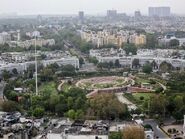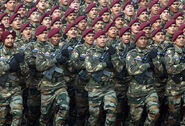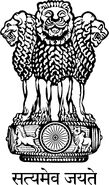This profile is for the nation of India from the Real World.
Summary[]
India (Hindi: Bhārat), officially the Republic of India (Hindi: Bhārat Gaṇarājya), is a country born from the independence from the British Commonwealth along with Pakistan next to it. It is a land of a long, and rich history and ancient culture rutted with it's people. And with a substantially strong military force to boot.
Command Structure[]
Leader(s)[]
Main Leaders[]
- Rajendra Prasad
- Sarvepalli Radhakrishnan
- Zakir Husain
- Varahagiri Venkata Giri
- Fakhruddin Ali Ahmed
- Neelam Sanjiva Reddy
- Zail Singh
- Ramaswamy Venkataraman
- Shankar Dayal Sharma
- Kocheril Raman Narayanan
- Avul Pakir Jainulabdeen Abdul Kalam
- Pratibha Patil
- Pranab Mukherjee
- Ram Nath Kovind
Second in Command[]
- Indira Priyadarshini Gandhi
- Narendra Damodardas Modi
Military Leaders[]
- Mohammad Zaman Kiani
- Mohan Singh
- Jaganath Rao Bhonsle
- Shah Nawaz Khan
- Prem Sahgal
- Lakshmi Sahgal
- Rajnath Singh
- Bipin Rawat
- Manoj Mukund Naravane
- Field Marshal K. M. Cariappa
- Field Marshal Sam Manekshaw
- General K. S. Thimayya
- Karambir Singh
- Rakesh Kumar Singh Bhadauria
Champions/Heroes/Notable Individuals[]
- Mohandas Karamchand Gandhi
- Subhas Chandra Bose
- Rash Behari Bose
- Anjana Bhaduria
- Sophia Qureshi
- Ganeve Lalji
Military Units[]
Infantry[]
- The Brigade of the Guards
- 1st Battalion (former 2nd battalion, 2nd Punjab Regiment)
- 2nd Battalion (former 1st battalion, 1st The Grenadiers)
- 3rd Battalion (former 1st battalion, 1st Rajputana Rifles)
- 4th Battalion (former 1st battalion, 1st Rajput Regiment)
- 5th Battalion (Highlanders) (Reconnaissance & Support)
- 6th Battalion
- 7th Battalion
- 8th Battalion
- 9th Battalion
- 10th Battalion
- 11th Battalion
- 12th Battalion (Reconnaissance & Support)
- 13th Battalion (Highlanders)
- 14th Battalion (Irregulars) (Param Vir Chakra Paltan)
- 15th Battalion (Reconnaissance & Support)
- 16th Battalion
- 17th Battalion
- 18th Battalion
- 19th Battalion (Reconnaissance & Support)
- 20th Battalion
- 22nd Battalion
- 117th Battalion (Territorial Army), Tiruchirapalli, Tamil Nadu
- 125th Battalion (Territorial Army), Secunderabad, Telangana
- 1st Battalion (Special Forces)
- 2nd Battalion (Special Forces)
- 3rd Battalion (Special Forces)
- 4th Battalion (Special Forces)
- 5th Battalion
- 6th Battalion
- 7th Battalion
- 23rd Battalion
- 29th Battalion
- 31th Battalion (Rashtriya Rifles)
- 106th Infantry Battalion (Territorial Army) (based at Bengaluru, Karnataka)
- 116th Infantry Battalion (Territorial Army) (based at Devlali, Maharashtra)
Cavarly[]
- 1st Horse or Skinner's Horse
- 3rd Cavalry
- 4th Horse or 'Hodson's Horse'
- 7th Cavalry
- 8th Cavalry
- 61th Cavalry
- 62th Cavalry
- 63th Cavalry
- 64th Cavalry
- 18th Cavalry
- 16th Cavalry
- 45th Cavalry
- 9th Horse or 'The Deccan Horse'
- 17th Horse (The Poona Horse)
- 14th Horse or 'The Scinde Horse'
- Central India Horse (in 21st position)
Elite[]
- 2nd Lancers
- 5th Armoured Regiment
- 6th Lancers
- 10th Armoured Regiment
- 11th Armoured Regiment The Regiment was raised by Col Harjeet Singh Lamba in May 1984 at Kalu Chak J&K
- 12th Armoured Regiment
- 13th Armoured Regiment
- 15th Armoured Regiment
- 19th Armoured Regiment
- 20th Lancers
- 40th Armoured Regiment
- 41th Armoured Regiment
- 42th Armoured Regiment
- 43th Armoured Regiment- The only regiment in the Armoured Corps to hold the MBT Arjun as part of its standard weapons platform.
- 44th Armoured Regiment
- 46th Armoured Regiment
- 47th Armoured Regiment
- 48th Armoured Regiment
- 49th Armoured Regiment
- 50th Armoured Regiment
- 51th Armoured Regiment
- 52th Armoured Regiment
- 53th Armoured Regiment
- 56th Armoured Regiment - Raised on 1 Oct 2011. Called "The LION HEARTS". It is the * * *
- Youngest Armoured Regt
- 65th Armoured Regiment
- 66th Armoured Regiment
- 67th Armoured Regiment
- 68th Armoured Regiment
- 69th Armoured Regiment
- 70th Armoured Regiment
- 71th Armoured Regiment
- 72th Armoured Regiment
- 73th Armoured Regiment
- 74th Armoured Regiment
- 75th Armoured Regiment - the only Indian armoured regiment to have been raised on foreign soil during the 1971 Indo-Pak war at Gadra Road (now in Pakistan)on 12 March 1972.
- 76th Armoured Regiment
- 81th Armoured Regiment
- 82th Armoured Regiment
- 83th Armoured Regiment
- 84th Armoured Regiment
- 85th Armoured Regiment
- 86th Armoured Regiment
- 87th Armoured Regiment
- 88th Armoured Regiment
- 89th Armoured Regiment
- 90th Armoured Regiment
- 91th Armoured Regiment
Special[]
- President's Bodyguard
- 9th Battalion (Special Forces)
- 10th Battalion (Special Forces)
- 11th Battalion (Special Forces)
- 12th Battalion (Special Forces)
- 21st Battalion (Special Forces)
Heavy[]
- 40th Artillery Division (Ambala, Haryana)(under Western Command).
- 41th Artillery Division (Pune, Maharashtra)(under Southern Command).
- 42th Artillery Division (Alwar, Rajasthan)(under South Western Command).
Vehicles[]
[]
- 1 aircraft carrier
- 1 amphibious transport dock
- 8 landing ship tanks
- 10 destroyers
- 13 frigates
- 22 corvettes
- 1 mine countermeasure vessel
- 2 nuclear submarines
- 15 diesel submarines
- 29 patrol vessels
- 4 replenishment oilers
- other auxiliary vessels
Aircraft[]
Command Buildings[]
- Headquarters
Supply Buildings[]
Research & Arsenal Buildings[]
Production/Construction/Training Buildings[]
- Military Airfields
- Military Barracks
- Military Factories
Other Buildings[]
Combative Buildings[]
Offensive Buildings[]
- Gun Nests
Defensive Buildings[]
Other Combative[]
- Missile Silos
Territories[]
New Dehli
- Age founded/conquered: 1947
- Territory type: Capital City
- Inhabitants: Indians
Mumbai
- Age founded/conquered: 1947
- Territory type: Largest city
- Inhabitants: Indians
Civilization Stats[]
Tier 9: Digital: India is among the top 12 biotech destinations in the world. The Indian biotech industry grew by 15.1% in 2012–2013, increasing its revenues from 204.4 billion INR (Indian rupees) to 235.24 billion INR (3.94 B US$ – exchange rate June 2013: 1 US$ approx. 60 INR).
Power Sources[]
Energy Source: Paraphernalia
Science: Substance Usage (The pharmaceutical industry in India is among the significant emerging markets for the global pharmaceutical industry. The Indian pharmaceutical market is expected to reach $48.5 billion by 2020. India's R & D spending constitutes 60% of the biopharmaceutical industry.)
Nature: Human Physiology (The members of the faction are humans with standard skills in combat)
Conquest Stats[]
Tier 9-A: Large-Country: is the seventh-largest country in the world, with a total area of 3,287,263 square kilometres (1,269,219 sq mi). India measures 3,214 km (1,997 mi) from north to south and 2,933 km (1,822 mi) from east to west. It has a land frontier of 15,200 km (9,445 mi) and a coastline of 7,516.6 km (4,671 mi).
With strength of over 1.4 million active personnel, it is the world's second-largest military force and has the world's largest volunteer army. According to a 2015 estimate by Credit Suisse, the Indian Armed Forces are the world's fifth-most powerful military. It has also the fourth-largest defense budget in the world.
Power Stats[]
Attack Potency: Town Level: Use the "Smiling Buddha Bomb", it is India's first nuke, it destroyed 8.15 km² with the thermal radiation and destroyed 6.77 km² with the air blast and released about 8 KT worth of TNT. Large Building: Indian Battleships with firing all of it's weapons at once. Small Building: Tanks that have the power to level small structures. Street: The energy from standard small firearms. Athletic Human: the strength of standard Indian soldiers.
Durability: Large Building: Indian Battleships which can take substantial explosions. Small Building: Tanks with armored plating can still operate even after explosions. Wall: Aircraft with it's large size. Street-Athletic: The durability with Indian soldiers with or without equipment.
Speed: Subsonic+: SU-30K top speed is 1317 mph. Superhuman: The The T-55 tank can go 50 km/h.. Athletic Human: The running speed of Indian soldiers.
Strengths/Pros[]
India is a federation with a parliamentary system governed under the Constitution of India—the country's supreme legal document. It is a constitutional republic and representative democracy, in which "majority rule is tempered by minority rights protected by law". Federalism in India defines the power distribution between the union, or central, government and the states.They have even been increasing their technological advancements in all three branches of the armed forces. Indian movies, music, and spiritual teachings play an increasing role in global culture. The Indian Armed Forces are the military forces of the Republic of India. It consists of three professional uniformed services: the Indian Army, Indian Navy, and Indian Air Force. Additionally, the Indian Armed Forces are supported by the Indian Coast Guard and paramilitary organizations (Assam Rifles, and Special Frontier Force) and various inter-service commands and institutions such as the Strategic Forces Command, the Andaman and Nicobar Command and the Integrated Defense Staff. The President of India is the Supreme Commander of the Indian Armed Forces. The Indian Armed Forces are under the management of the Ministry of Defense (MoD) of the Government of India.
India is a nuclear weapons state, which ranks high in military expenditure. It has a space program which includes several planned or completed extraterrestrial missions.
Weaknesses/Flaws[]
Despite economic growth during recent decades, India continues to face socio-economic challenges. In 2006, India contained the largest number of people living below the World Bank's international poverty line of US$1.25 per day. The proportion decreased from 60% in 1981 to 42% in 2005. Under the World Bank's later revised poverty line, it was 21% in 2011. 30.7% of India's children under the age of five are underweight. According to a Food and Agriculture Organization report in 2015, 15% of the population is undernourished. The Mid-Day Meal Scheme attempts to lower these rates. There has been unrest in religious and gender groups, as well as air pollution problems.
Wins/Loses[]
When a battle is decided, list the wins and loses below.




